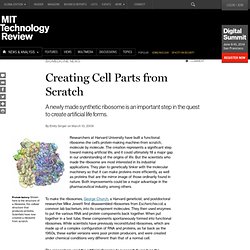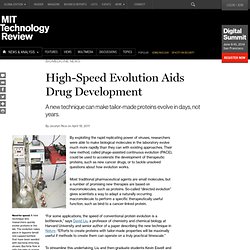

Andrew Hessel on Singularity 1 on 1: How Synthetic Biology May Help Cure Cancer. Bryan Bishop presents at and reports from H+ Summit 2009. Here I go.

Start off with something like “Bryan got to speak at H+ Summit 2009 and spotted some neat numbers.” Maybe this will end up in GBM or H+ magazine as a small blurb? Bryan Bishop presented at the 2009 H+ Summit onopen source hardware and took copious notes. Here he presents some of his favorites: Patri Friedman. Todd Huffman also talked (transcript). Gregory Benford (transcript) also showed up and talked about personal genomics, or what he calls “nutrigenomics”.
You should also check out Anselm Levskaya‘s talk on brain input/output projects, Dylan Morris, and Christine Peterson had some good suggestions for not dying. And one final plug- there’s no transcript for me because I was presenting (!) "Reading & Writing Genomes" - George Church @ '09 DOE JGI User Meeting. Creating Cell Parts from Scratch. Researchers at Harvard University have built a functional ribosome–the cell’s protein-making machine–from scratch, molecule by molecule.

The creation represents a significant step toward making artificial life, and it could ultimately fill a major gap in our understanding of the origins of life. But the scientists who made the ribosome are most interested in its industrial applications. They plan to genetically tinker with the molecular machinery so that it can make proteins more efficiently, as well as proteins that are the mirror image of those ordinarily found in nature. Both improvements could be a major advantage in the pharmaceutical industry, among others.
To make the ribosomes, George Church, a Harvard geneticist, and postdoctoral researcher Mike Jewett first disassembled ribosomes from Escherichia coli, a common lab bacterium, into its component molecules. Next, the researchers want to create a ribosome that can re-create itself. Gene Sequencing for the Masses. An inexpensive new gene-sequencing machine is due to hit the market next month, and its creators hope that it will make sequencing more common, ultimately giving a boost to personalized medicine.

The machine is the brainchild of George Church, a genomics pioneer who developed the first direct sequencing technology as a graduate student in the 1980s and helped initiate the Human Genome Project soon after. Church sees greater access to sequencing as a vital component in the drive toward personalized medicine, in which treatments and preventative medicine are tailored to an individual’s genetic makeup.
The new machine, which was developed with an “open source” philosophy, was commercialized by Danaher Motion, based in Salem, NH, with the specific intent of keeping costs low. “It seems like the biomedical-instrument field in general tries not to commoditize,” says Church, who heads the Center for Computational Genetics at Harvard Medical School, in Boston. High-Speed Evolution Aids Drug Development. By exploiting the rapid replicating power of viruses, researchers were able to make biological molecules in the laboratory evolve much more rapidly than they can with existing approaches.

Their new method, called phage-assisted continuous evolution (PACE), could be used to accelerate the development of therapeutic proteins, such as new cancer drugs, or to tackle unsolved questions about how evolution works. Most traditional pharmaceutical agents are small molecules, but a number of promising new therapies are based on macromolecules, such as proteins. So-called “directed evolution” gives scientists a way to adapt a naturally occurring macromolecule to perform a specific therapeutically useful function, such as bind to a cancer-linked protein. “For some applications, the speed of conventional protein evolution is a bottleneck,” says David Liu, a professor of chemistry and chemical biology at Harvard University and senior author of a paper describing the new technique in Nature.
(4) George Church. Growing a New York biotech culture. New York City plays catch-up to create centers, attract venture capital.

Published on 6 November 2011 by Crain’s New York Business The city's medical-science establishment needs a more entrepreneurial mindset, says Frank Rimalovski, who runs NYU's new $20 million biotech venture fund. After New York University announced its $20 million Innovation Venture Fund last year, Frank Rimalovski met with a professor from the university’s medical school. “The professor whipped out the press release [on the venture fund] and said, ‘Before I read this, I never realized I could do something like this,’ “ recalled Mr.
Rimalovski, a former venture capitalist and head of the new fund—seed money for biotech and other technology startups. Mr. In recent years, the Bloomberg administration and its partners in academia and business have worked to overcome barriers to commercial biotech, from lack of space to lack of funding. Venture capitalists put about $3.8 billion into U.S. biotech companies last year. Ms.